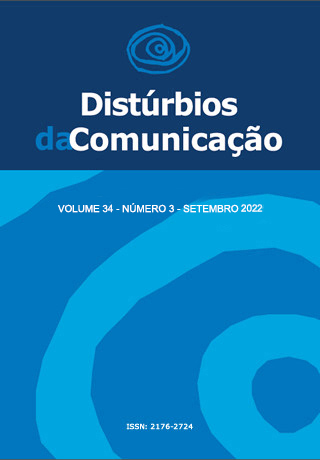Eating and Drinking Ability Classification System – EDACS
cross-cultural adaptation of the Brazilian Portuguese
DOI:
https://doi.org/10.23925/2176-2724.2022v34i3e56470Keywords:
Deglutition disorders, Feeding, Cerebral palsy, Evaluation, Scale, ChildAbstract
Objective: to perform the translation and cultural equivalence to Brazilian Portuguese of the Eating and Drinking Ability Classification System (EDACS). Method: EDACS was translated into Brazilian Portuguese by two bilingual speech language therapists, specialists in dysphagia. The two translations were compared by the speech therapists, the incompatibilities were discussed among themselves and decisions were taken by consensus. After the instrument was translated, it was sent to a third Brazilian speech language therapist, bilingual and resident in the United States, for back-translation into English. The initial version of the instrument and the back-translation were compared and the discrepancies were analyzed, discussed and defined by consensus. Results: the processes of translation and cultural adaptation required more effort in defining the terms of the used consistencies and did not change the structure of the original scale. Conclusion: the cultural equivalence of the Sistema de Classificação das Habilidades do Comer e Beber – EDACS-PT/BR was performed for Brazilian Portuguese.
Downloads
References
Calis EA, Veugelers R, Sheppard JJ, Tibboel D, Evenhuis HM, Penning C. Dysphagia in children with severe generalized cerebral palsy and intellectual disability. Dev Med Child Neurol. 2008; 50(8): 625-30.
Arvedson JC. Feeding children with cerebral palsy and swallowing difficulty. Eur J Clin Nutr. 2013; 67: S9-S12
Benfer KA, Weir KA, Bell KL, Ware RS, Davies PSW, Boyd RN. Validity and reproducibility of measures of oropharyngeal dysphagia in preschool children with cerebral palsy. Dev Med Child Neurol. 2015; 57: 358-365.
Benfer KA, Weir KA, Bell KL, Ware RS, Davies PSW, Boyd RN. Oropharyngeal dysphagia and gross motor skills in children with cerebral palsy. Pediatrics. 2013; 131(5): e1553-e1562.
Kim JS, Han ZA, Song DH, Oh HM, Chung ME. Characteristics of dysphagia in children with cerebral palsy, related to gross motor function. Am J Phys Med Rehabil. 2013; 92(10): 912-919.
Morton R, Wheatley R, Minford J. Respiratory tract infections due to direct and reflux aspiration in children with severe neurodisability. Dev Med Child Neurol. 1999; 41: 329-34.
Silvério CC, Henrique CS. Indicadores da evolução do paciente com paralisia cerebral e disfagia orofaríngea após intervenção terapêutica. Rev Soc Bras Fonoaudiol. 2009; 14(3): 381-386.
Lefton-Greif MA, Okelo SO, Wright JM, Colaco JM, McGrath-Morrow SA, Eakin MN. Impact of children´s feeding/swallowing problems: validation of a new caregiver instrument. Dysphagia. 2014; 29: 671-677.
Benfer KA, Weir KA, Bell KL, Ware RS, Davies PSW, Boyd RN. Oropharyngeal dysphagia in preschool children with cerebral palsy: oral phase impairments. Res Dev Disabil. 2014; 35: 3469-3481.
Mishra A, Sheppard JJ, Kantarcigil C, Gordon AM, Malandraki GA. Novel mealtime duration measures: reliability and preliminary associations with clinical feeding and swallowing performance in self-feeding children with cerebral palsy. Am J Speech Lang Pathol. 2018; 27: 99-107.
Crary MA, Carnaby GD, Groher ME. Initial psychometric assessment of a functional oral intake scale for dysphagia in stroke patients. Arch Phys Med Rehabil 2005; 86: 1516-1520.
Sellers D, Mandy A, Pennington L, Hankins M, Morris C. Development and reliability of a system to classify the eating and drinking ability of people with cerebral palsy. Dev Med Child Neurol. 2014b; 56(3): 245-51.
Kitai Y, Hirai S. Okuyama N, Hirotsune M, Nishimoto S, Hirano S, et al. Functional outcomes of children with dyskinetic cerebral palsy depend on etiology and gestational age. Eur J Paediatr Neurol 2021; 30: 108-112.
Ron AG, Toboso RMG, Gascón MB, Santos MT, Vecino R, Pinedo AB. Nutritional status and prevalence of dysphagia in cerebral palsy: usefulness of the eating and drinking ability classification system scale and correlation with the degree of motor impairment according to the gross motor function classification system. Neurologia (Engl Ed) 2020; S0213-4853(20)30044-X.
Bell KL, Benfer KA, Ware RS, Patrao TA, Garvey JJ, Arvedson JC, et al. Development and validation of a screening tool for feeding/swallowing difficulties and undernutrition in children with cerebral palsy. Dev Med Child Neurol 2019; 61: 1175-1181.
Rosenbaum P, Paneth N, Leviton A, Goldstein M, Bax M, Damiano D, et al. A report: the definition and classification of cerebral palsy. Dev Med Child Neurol. 2007; 109: 8-14.
Scientific Advisory Committee of Medical Outcomes Trust. Assessing health status and quality of life instruments: attributes and review criteria. Qual Life Res. 2002;11(3): 193-205.
Pernambuco L, Espelt A, Magalhães Júnior, HV, Lima, KC. Recomendações para elaboração, tradução, adaptação transcultural e processo de validação de testes em Fonoaudiologia. CoDAS 2017; 29(3): e20160217 doi:10.1590/2317-1782/20172016217.
Hyun SE, Yi YG, Shin H. Reability and Validity of the Eating and Drinking Ability Classification System in adults with cerebral palsy. Dysphagia 2021; 36: 351-361.
Viñals-Labañino CP, Velazquez-Bustamante AE, Vargas-Santiago SI, Arenas-Sordo ML. Useful of cerebral palsy curves in Mexican patients: a cross-sectional study. J Child Neurol 2019; 34: 332-338.
Goh YR, Choi JY, Kim SA, Park J, Park ES. Comparations of severity classification systems for oropharyngeal dysfunctions in children with cerebral palsy: relations with other functional profiles. Res Dev Disabil 2018; 72: 248-256.
Downloads
Published
Issue
Section
License
Copyright (c) 2022 Carolina Castelli Silvério, Diane Sellers, Daniella Curcio, Maria Inês Rebelo Gonçalves

This work is licensed under a Creative Commons Attribution 4.0 International License.









